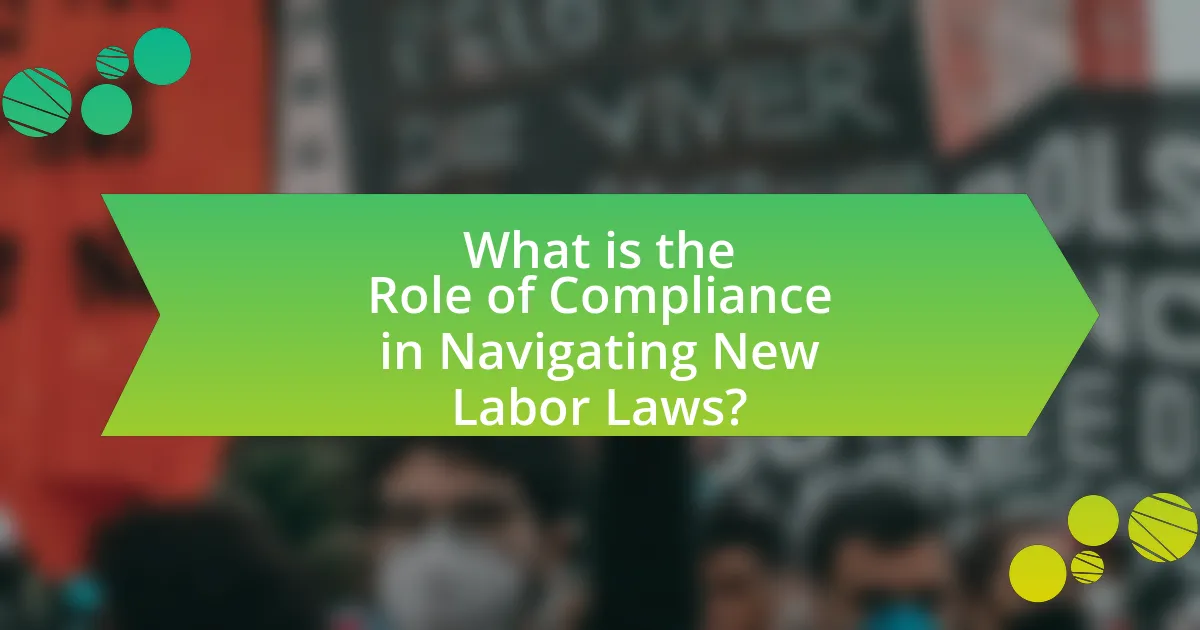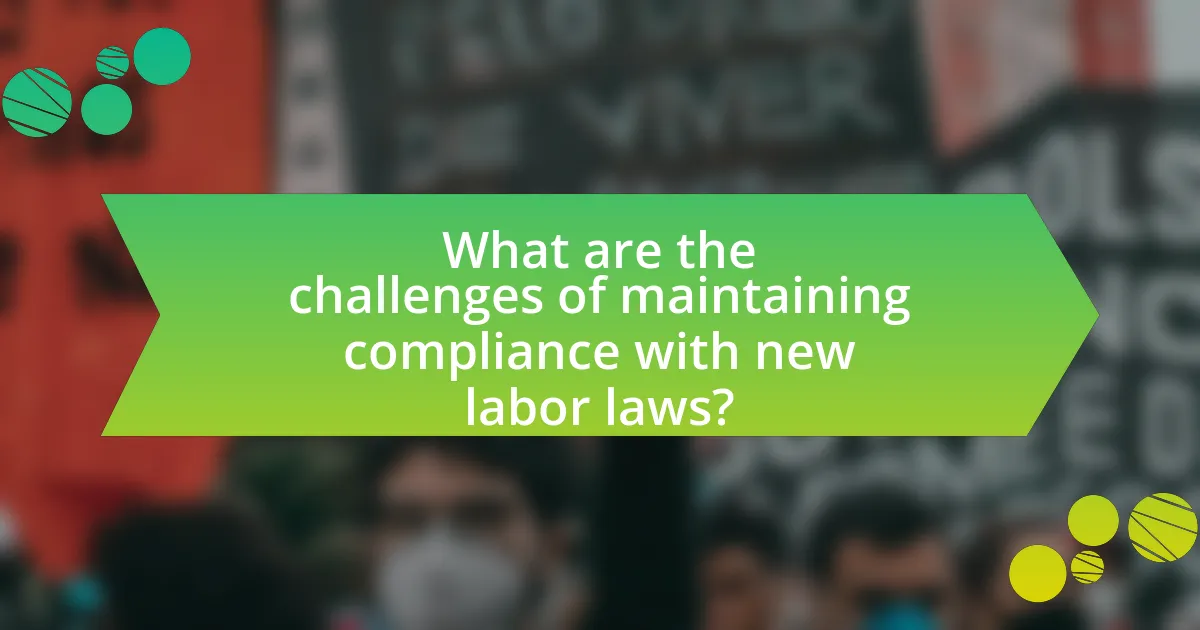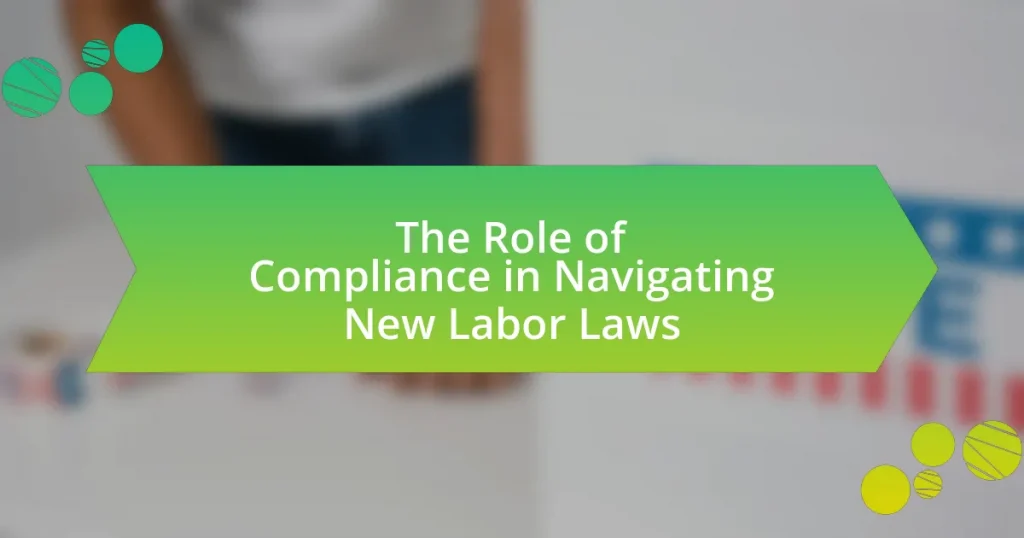Compliance is essential for organizations to effectively navigate new labor laws, ensuring adherence to legal standards and minimizing risks associated with non-compliance, such as legal disputes and financial penalties. The article outlines the critical components of compliance, including employee rights protection, workplace safety standards, and proper record-keeping, while emphasizing the importance of continuous training and monitoring. It also discusses the challenges businesses face in maintaining compliance, the role of technology in streamlining compliance processes, and best practices for implementing effective compliance strategies. Additionally, the article highlights the implications of non-compliance across different jurisdictions and provides resources for businesses to stay updated on evolving labor laws.

What is the Role of Compliance in Navigating New Labor Laws?
Compliance plays a critical role in navigating new labor laws by ensuring that organizations adhere to legal standards and regulations. This adherence helps prevent legal disputes, fines, and reputational damage. For instance, the U.S. Department of Labor reported that non-compliance with labor laws can lead to penalties exceeding $10,000 per violation. By implementing compliance programs, businesses can effectively monitor changes in legislation, train employees, and establish protocols that align with new requirements, thereby fostering a culture of accountability and legal awareness.
How does compliance influence the implementation of new labor laws?
Compliance significantly influences the implementation of new labor laws by ensuring that organizations adhere to legal standards and regulations. When businesses prioritize compliance, they are more likely to adopt necessary changes in policies and practices that align with new labor laws, thereby reducing the risk of legal penalties and fostering a culture of accountability. For instance, a study by the International Labour Organization found that companies with robust compliance programs are 30% less likely to face labor disputes, indicating that effective compliance mechanisms facilitate smoother transitions to new legal frameworks.
What are the key components of compliance in labor law?
The key components of compliance in labor law include adherence to regulations, employee rights protection, workplace safety standards, and proper record-keeping. Adherence to regulations ensures that organizations follow federal, state, and local labor laws, which can include wage and hour laws, anti-discrimination laws, and family leave policies. Protecting employee rights involves ensuring fair treatment, non-discrimination, and the right to organize. Workplace safety standards are governed by regulations such as those set by the Occupational Safety and Health Administration (OSHA), which mandates safe working conditions. Proper record-keeping is essential for demonstrating compliance and includes maintaining accurate payroll records, employee classifications, and documentation of workplace policies. These components collectively ensure that organizations operate within the legal framework and protect both employees and employers from potential legal issues.
How do these components interact with new labor regulations?
Components such as employee rights, employer obligations, and regulatory frameworks interact with new labor regulations by ensuring that both parties adhere to updated legal standards. Employee rights are enhanced through regulations that mandate fair wages, safe working conditions, and anti-discrimination measures, compelling employers to adjust their practices accordingly. Employer obligations are defined by these regulations, requiring compliance with labor laws to avoid penalties and legal repercussions. Regulatory frameworks provide the structure within which these interactions occur, guiding the implementation of labor laws and ensuring enforcement. For instance, the Fair Labor Standards Act establishes minimum wage and overtime pay requirements, directly influencing employer policies and employee protections.
Why is compliance critical for businesses facing new labor laws?
Compliance is critical for businesses facing new labor laws because it ensures adherence to legal standards, thereby minimizing the risk of penalties and legal disputes. Non-compliance can lead to significant financial repercussions, including fines that can reach thousands of dollars per violation, as well as potential lawsuits that can damage a company’s reputation and operational viability. For instance, the U.S. Department of Labor reported that employers who fail to comply with wage and hour laws can face back pay liabilities that exceed the original unpaid wages. Therefore, maintaining compliance not only protects businesses from legal consequences but also fosters a positive workplace culture and enhances employee trust.
What risks do businesses face without proper compliance?
Businesses face significant risks without proper compliance, including legal penalties, financial losses, and reputational damage. Non-compliance can lead to fines that may reach millions of dollars, as evidenced by the U.S. Department of Labor imposing over $300 million in penalties for labor law violations in 2020 alone. Additionally, companies may experience operational disruptions due to investigations or lawsuits, which can further strain resources and impact profitability. Furthermore, a lack of compliance can erode customer trust and brand reputation, leading to decreased sales and market share.
How can compliance enhance a company’s reputation and trust?
Compliance enhances a company’s reputation and trust by demonstrating a commitment to ethical practices and legal standards. When a company adheres to regulations, it signals to stakeholders, including customers and investors, that it prioritizes integrity and accountability. This adherence can lead to increased customer loyalty, as consumers are more likely to support businesses that operate transparently and responsibly. For instance, a study by the Ethics & Compliance Initiative found that organizations with strong compliance programs experience higher levels of employee engagement and lower turnover rates, which further contributes to a positive public image. Additionally, compliance can mitigate risks associated with legal penalties and reputational damage, reinforcing stakeholder confidence in the company’s operations.

What are the challenges of maintaining compliance with new labor laws?
Maintaining compliance with new labor laws presents challenges such as the complexity of regulations, the need for continuous training, and the potential for increased operational costs. The complexity arises from the frequent updates and variations in laws across different jurisdictions, making it difficult for organizations to stay informed. Continuous training is essential to ensure that employees and management understand the new requirements, which can strain resources and time. Additionally, compliance often necessitates investments in new systems or processes, leading to increased operational costs. These factors collectively hinder organizations’ ability to effectively navigate and adhere to evolving labor laws.
How do varying state and federal laws complicate compliance?
Varying state and federal laws complicate compliance by creating a patchwork of regulations that organizations must navigate. For instance, while federal laws like the Fair Labor Standards Act set minimum wage and overtime requirements, individual states may impose higher standards, leading to confusion about which regulations to follow. This complexity is further exacerbated by differences in enforcement mechanisms and penalties across jurisdictions, making it challenging for businesses to ensure they meet all legal obligations. Consequently, organizations may face increased legal risks and administrative burdens as they attempt to align their practices with both state and federal requirements.
What are the implications of non-compliance in different jurisdictions?
Non-compliance with labor laws in different jurisdictions can lead to severe legal and financial repercussions for businesses. In the United States, for instance, violations of the Fair Labor Standards Act can result in back pay, fines, and even criminal charges, depending on the severity of the infraction. In the European Union, non-compliance with directives such as the Working Time Directive can lead to penalties imposed by national authorities, including fines and mandatory compensation for affected employees. Furthermore, in countries like Australia, breaches of the Fair Work Act can result in significant financial penalties and reputational damage, as well as potential litigation from employees. These implications underscore the necessity for businesses to adhere to local labor laws to avoid costly consequences.
How can businesses stay updated on changing labor laws?
Businesses can stay updated on changing labor laws by subscribing to legal updates from reputable sources, such as government websites, legal firms, and industry associations. These sources often provide timely information on legislative changes, regulatory updates, and compliance guidelines. For instance, the U.S. Department of Labor regularly publishes updates on federal labor laws, while organizations like the Society for Human Resource Management offer resources tailored to specific industries. Additionally, attending workshops, webinars, and conferences focused on labor law can enhance understanding and provide networking opportunities with legal experts.
What role does technology play in ensuring compliance?
Technology plays a crucial role in ensuring compliance by automating processes, monitoring activities, and providing real-time data analysis. Automated compliance management systems streamline the tracking of regulatory requirements, reducing human error and increasing efficiency. For instance, software solutions can automatically update organizations on changes in labor laws, ensuring that they remain compliant with the latest regulations. Additionally, data analytics tools enable organizations to assess compliance risks and identify areas needing improvement, thereby enhancing overall compliance strategies. According to a report by Deloitte, companies that leverage technology for compliance can reduce compliance costs by up to 30%, demonstrating the effectiveness of technology in maintaining adherence to labor laws.
How can compliance software assist in navigating labor laws?
Compliance software assists in navigating labor laws by automating the tracking and management of regulatory requirements. This software provides real-time updates on changes in labor legislation, ensuring organizations remain compliant with federal, state, and local laws. For instance, according to a report by the Society for Human Resource Management, companies using compliance software experience a 30% reduction in compliance-related errors, which highlights its effectiveness in maintaining adherence to labor regulations. Additionally, compliance software often includes features such as document management, employee training modules, and audit trails, which further streamline compliance processes and mitigate risks associated with non-compliance.
What are the benefits of using technology for compliance tracking?
Using technology for compliance tracking enhances efficiency, accuracy, and accountability in managing regulatory requirements. Automated systems streamline data collection and reporting processes, reducing the risk of human error and ensuring timely compliance with labor laws. For instance, organizations utilizing compliance management software can achieve up to a 50% reduction in time spent on compliance tasks, as reported by a study from the Compliance and Ethics Institute. Additionally, technology provides real-time monitoring and alerts for compliance deadlines, which helps organizations avoid costly penalties associated with non-compliance. Overall, the integration of technology in compliance tracking leads to improved operational effectiveness and better risk management.

How can businesses effectively implement compliance strategies for new labor laws?
Businesses can effectively implement compliance strategies for new labor laws by conducting thorough assessments of existing policies and practices to identify gaps. This involves reviewing current labor law requirements, training staff on new regulations, and updating employee handbooks to reflect changes. For instance, a study by the Society for Human Resource Management found that organizations that regularly audit their compliance practices are 30% more likely to adhere to new labor laws. Additionally, establishing a dedicated compliance team can facilitate ongoing monitoring and adaptation to legal changes, ensuring that businesses remain compliant and mitigate risks associated with non-compliance.
What best practices should businesses adopt for compliance?
Businesses should adopt a comprehensive compliance program that includes regular training, clear policies, and ongoing monitoring. Regular training ensures that employees understand labor laws and compliance requirements, while clear policies provide guidelines for acceptable behavior and procedures. Ongoing monitoring, including audits and assessments, helps identify potential compliance issues before they escalate. According to a study by the Ethics & Compliance Initiative, organizations with strong compliance programs experience 50% fewer incidents of misconduct, demonstrating the effectiveness of these best practices in maintaining compliance.
How can training programs enhance employee understanding of compliance?
Training programs enhance employee understanding of compliance by providing structured education on legal requirements and organizational policies. These programs often include interactive elements such as case studies, quizzes, and role-playing scenarios that facilitate active learning and retention of compliance concepts. Research indicates that organizations with comprehensive training programs see a 50% reduction in compliance violations, demonstrating the effectiveness of targeted education in fostering a culture of compliance.
What role does communication play in successful compliance implementation?
Communication is essential for successful compliance implementation as it ensures that all stakeholders understand the requirements and expectations of new labor laws. Effective communication facilitates the dissemination of information, clarifies roles and responsibilities, and fosters a culture of accountability. Research indicates that organizations with strong communication strategies are 50% more likely to achieve compliance goals, as they can effectively engage employees and address concerns promptly. This alignment between management and staff enhances adherence to regulations, ultimately reducing the risk of non-compliance penalties.
What resources are available for businesses to aid in compliance?
Businesses can utilize various resources to aid in compliance with labor laws, including legal counsel, compliance software, training programs, and industry guidelines. Legal counsel provides expert advice on navigating complex regulations, ensuring that businesses understand their obligations. Compliance software automates tracking and reporting, helping organizations maintain adherence to laws efficiently. Training programs educate employees on compliance requirements, fostering a culture of awareness and accountability. Additionally, industry guidelines offer best practices tailored to specific sectors, helping businesses align their operations with legal standards. These resources collectively enhance a business’s ability to comply with evolving labor laws effectively.
How can legal counsel assist in navigating new labor laws?
Legal counsel can assist in navigating new labor laws by providing expert guidance on compliance requirements and legal implications. They analyze the specific provisions of new legislation, ensuring that organizations understand their obligations and rights under the law. For instance, legal counsel can help interpret complex regulations, draft necessary policies, and implement training programs to educate employees about changes in labor laws. This support is crucial, as non-compliance can lead to significant penalties; for example, the U.S. Department of Labor reported that employers faced over $300 million in fines for wage and hour violations in 2020. By leveraging their expertise, legal counsel helps organizations mitigate risks and maintain compliance with evolving labor laws.
What online resources provide updates and guidance on labor law compliance?
Online resources that provide updates and guidance on labor law compliance include the U.S. Department of Labor (DOL) website, which offers comprehensive information on federal labor laws, regulations, and compliance assistance. Additionally, the Society for Human Resource Management (SHRM) provides resources, articles, and webinars focused on labor law updates and best practices for compliance. The National Labor Relations Board (NLRB) also offers guidance on labor relations and compliance with the National Labor Relations Act. These resources are regularly updated to reflect changes in legislation and provide practical guidance for employers and HR professionals.
What are the common pitfalls in compliance with new labor laws?
Common pitfalls in compliance with new labor laws include inadequate training of employees, failure to update policies, and lack of monitoring for compliance. Inadequate training can lead to misunderstandings of the new regulations, resulting in unintentional violations. Failure to update policies means that organizations may continue to operate under outdated guidelines, which can expose them to legal risks. Additionally, a lack of monitoring can prevent organizations from identifying compliance issues early, leading to potential penalties or lawsuits. According to a 2021 survey by the Society for Human Resource Management, 60% of organizations reported challenges in keeping up with changing labor laws, highlighting the importance of proactive compliance strategies.
How can businesses avoid misinterpretation of labor laws?
Businesses can avoid misinterpretation of labor laws by implementing comprehensive training programs for employees and management on current regulations. Regularly updating these training sessions ensures that all staff are informed about changes in labor laws, which can vary by jurisdiction. Additionally, consulting with legal experts or compliance officers can provide clarity on complex legal language and requirements. According to the Society for Human Resource Management, organizations that invest in compliance training reduce the risk of legal disputes and enhance workplace understanding of labor regulations.
What steps can be taken to rectify compliance failures?
To rectify compliance failures, organizations should first conduct a thorough assessment to identify the specific areas of non-compliance. This assessment involves reviewing policies, procedures, and practices against applicable labor laws and regulations. Following the assessment, organizations must implement corrective actions, which may include updating policies, providing additional training to employees, and enhancing monitoring systems to ensure ongoing compliance.
For instance, a study by the Society for Human Resource Management found that organizations that regularly review and update their compliance programs are 30% less likely to experience compliance failures. Additionally, establishing a culture of compliance within the organization, where employees are encouraged to report issues without fear of retaliation, further strengthens compliance efforts.
What practical steps can businesses take to ensure compliance with new labor laws?
Businesses can ensure compliance with new labor laws by conducting regular audits of their policies and practices. This involves reviewing employee handbooks, payroll systems, and workplace safety protocols to align with the latest legal requirements. For instance, the U.S. Department of Labor mandates that employers adhere to the Fair Labor Standards Act, which sets standards for minimum wage and overtime pay. By implementing training programs for management and staff on these laws, businesses can foster a culture of compliance. Additionally, consulting with legal experts or compliance officers can provide tailored guidance to navigate complex regulations effectively. Regular updates and communication about changes in labor laws are essential to maintain compliance and avoid penalties.






